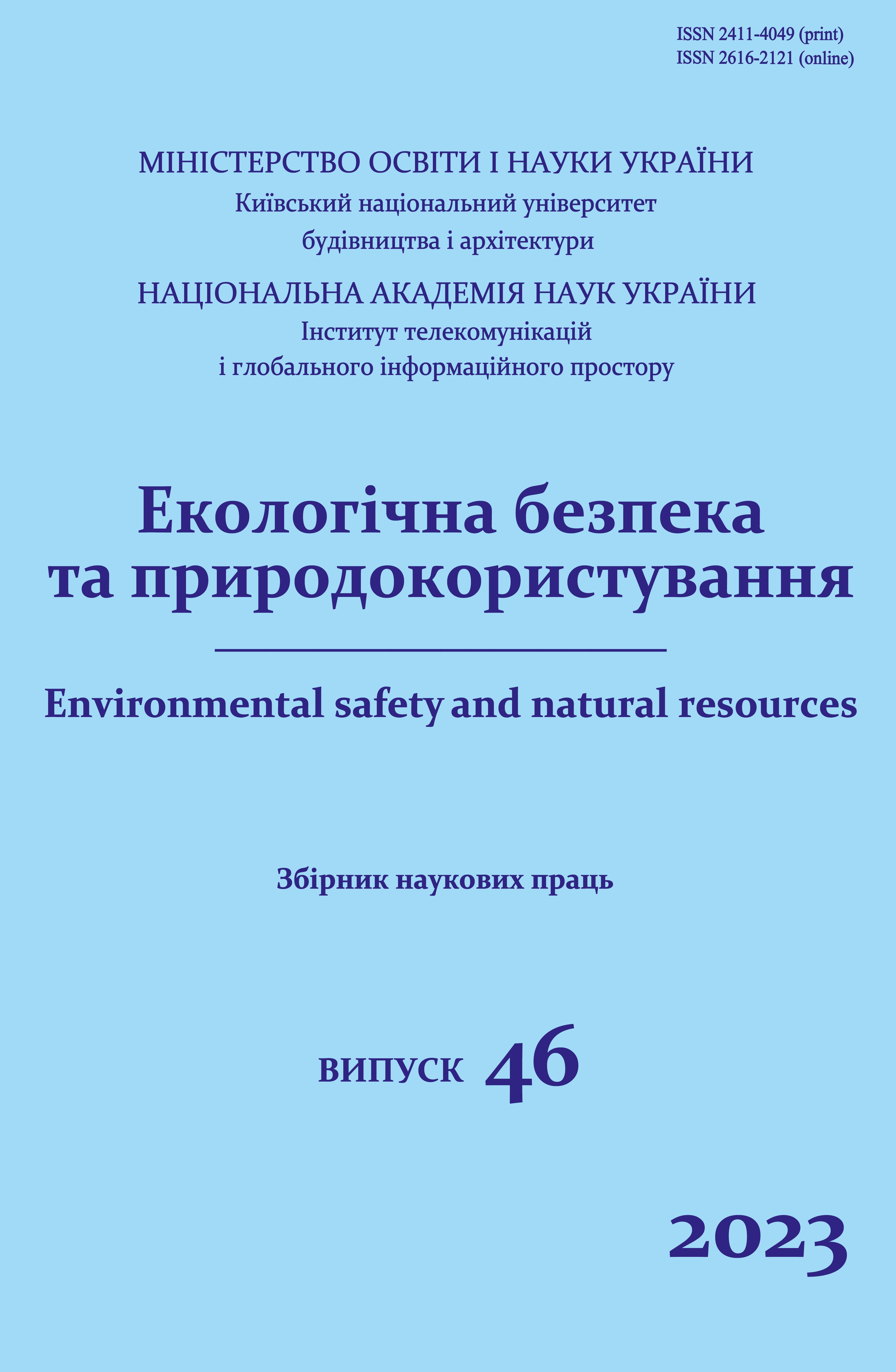Decision-making information technologies for the resources determination of forest fire extinguishing by aviation
DOI:
https://doi.org/10.32347/2411-4049.2023.2.109-123Keywords:
AHP, ANP, acceptable vote, visualization, graphs, ecological safetyAbstract
The article proposes a solution to the scientific and applied problem of decision support automation in case of determined resource provision of civil defense forces for extinguishing forest fires. This topic is of great relevance both in peacetime and in the conditions of the current armed aggression of the Russian Federation against Ukraine. The solved task is an important element of resolution the more complex problem of prompt response to emergency situations in the ecological and technogenic spheres. To solve this problem, a software environment for automated decision-making support by experts is proposed based on the integration method, which provides structuring of data, support of expert judgments, and visualization of decision-making processes. The functionality of this software environment is considered on the example of the use of the integration expert method and relevant information technologies to determine the resources of aviation groups for the purpose of forming a plan of operational response to the elimination of forest fires. A hierarchical model of the problem is given in accordance with AHP requirements. Also, in order to increase the effect of the conducted modeling and ranking of alternatives, the use of a network model of the problem and ANP application (which is a AHP development) to support decision-making are proposed. The ANP implementation is illustrated using the freely distributed SuperDecisions software. The developed scientific and practical approaches and toolkit are intended for functioning in operational units of the state service for emergency situations, but they can also be used in other power structures. The obtained results are aimed at increasing the level of environmental safety in forest areas and can be used to support nature management in different regions.
References
Nesterenko, O.V. (2021). Expert assessment of capabilities civil defense forces. Environmental Safety and Natural Resources, 39(3), 88–101 [in Ukrainian]. https://doi.org/10.32347/2411-4049.2021.3.88-101
Zibtsev, S.V., Soshenskyi, O.M., Myroniuk, V.V., & Humeniuk, V.V. (2020). Landscape fires in Ukraine: current situation and analysis of the current system of protection of natural areas from fires. Ukrainskyi zhurnal lisivnytstva ta derevynoznavstva, 2, 15-31 [in Ukrainian].
Khyzhniak, V.V., & Shevchenko V.L. (2017). Theoretical foundations of innovative solutions in the management of flight safety of state aviation. Tsyvilnyi zakhyst ta pozhezhna bezpeka, 4 (2), 73-80 [in Ukrainian].
Thiebes, B., & Winkhardt-Enz, R. (2022). Challenges and opportunities using new modalities and technologies for multi-risk management. Natural Hazards, 1-4. https://doi.org/10.1007/s11069-022-05516-3
Goode, EJ, Thomas, E., Landeg, O., et al. (2021). Development of a Rapid Risk and Impact Assessment Tool to Enhance Response to Environmental Emergencies in the Early Stages of a Disaster: A Tool Developed by the European Multiple Environmental Threats Emergency NETwork (EMETNET) Project. International journal of disaster risk science, 12(4), 528-539. https://doi.org/10.1007/s13753-021-00352-8
Wang, L., Wu, P., & Chu, F. (2020). A multi-objective emergency scheduling model for forest fires with priority areas. Proceeding of IEEE International Conference on Industrial Engineering and Engineering Management, December, 2020, 610–614, 9309821. https://doi.org/10.1109/IEEM45057.2020.9309821
Ekström, L., & Große, C. (2020). Choice of airport in extinguishing wildfires: Model and cases. Proceedings of the 9th International Conference on Operations Research and Enterprise Systems ICORES 2020, 22- 24 February, 2020, Valletta. 158677, 364-371.
Pagano, A., Giordano, R., & Vurro, M. (2021). A Decision Support System Based on AHP for Ranking Strategies to Manage Emergencies on Drinking Water Supply Systems. Water Resources Management, 35, 1-16. https://doi.org/10.1007/s11269-020-02741-y
Bruzzese, S., Blanc, S., Novelli, S., & Brun, F. (2023). A Multicriteria Analysis to Support Natural Resource Governance: The Case of Chestnut Forests. Research, 12 (3), 40. https://doi.org/10.3390/resources12030040
Rivière, M., Lenglet, J., Noirault, A., Pimont, F., & Dupuy, J-L. (2023). Mapping territorial vulnerability to wildfires: A participative multi-criteria analysis. Forest Ecology and Management, 539, 121014. https://doi.org/10.1016/j.foreco.2023.121014.2
Padilla, L.M., Creem-Regehr, S.H., Hegarty, M. et al. (2018). Decision making with visualizations: a cognitive framework across disciplines. Cogn. Research, 3, 29. https://doi.org/10.1186/s41235-018-0120-9
Hindalong, E., Johnson, J., Carenini, G., Munzner, T. (2020). Towards Rigorously Designed Preference Visualizations for Group Decision Making. Proceedings of the IEEE Pacific Visualization Symposium (PacificVis), 14-17 April, 2020, Tianjin, China, 181-190. https://doi.org/10.1109/PacificVis48177.2020.5111
Vitolo, C., Di Napoli, C., Di Giuseppe, F., Hannah, L. C., & Pappenberger, F. (2019). Mapping combined wildfire and heat stress hazards to improve evidence-based decision making. Environment International, 127, 21-34. https://doi.org/10.1016/j.envint.2019.03.008
Nesterenko, O., & Trofymchuk O. (2019). Patterns in forming the ontology-based environment of information-analytical activity in administrative management. Eastern-European Journal of Enterprise Technologies. 5/2 (101). 33-42. https://doi.org/10.15587/1729-4061.2019.180107
Xu, F.-X., Liu, X.-H., Chen, W., Zhou, C., & Cao, B.-W. (2018). An ontology and AHP based quality evaluation approach for reuse parts of end-of-life construction machinery. Mathematical Problems in Engineering. 3481030. https://doi.org/10.1155/2018/3481030
Nesterenko, O., Netesin, I., Polischuk, V., & Selin, Y. (2021). Multifunctional Methodology of Expert Evaluation Alternatives in Tasks of Different Information Complexity. Proceedings of the IEEE 3rd International Conference on Advanced Trends in Information Theory (ATIT), 226-231. https://doi.org/10.1109/ATIT54053.2021.96787428
Nesterenko, O., Netesin, I., Polischuk, V., & Trofymchuk, O. (2020). Development of a procedure for expert estimation of capabilities in defense planning under multicriterial conditions. Eastern-European Journal of Enterprise Technologies, 4/2 (106), 33-43. https://doi.org/10.15587/1729-4061.2020.208603
Polishchuk, V.B., Netesin, I.E., Nesterenko, O.V. et al. (2021). Information technologies in the management of defense resources: methodological context and examples of practical implementation. Part 2. Monograph. [Ed. V.B. Polishchuk]. Kyiv: UkrNTs RIT.
Downloads
Published
How to Cite
Issue
Section
License
Copyright (c) 2023 Nesterenko O.V., Polischuk V.B., Khyzhniak V.V., Shevchenko V.L.

This work is licensed under a Creative Commons Attribution 4.0 International License.
The journal «Environmental safety and natural resources» works under Creative Commons Attribution 4.0 International (CC BY 4.0).
The licensing policy is compatible with the overwhelming majority of open access and archiving policies.

